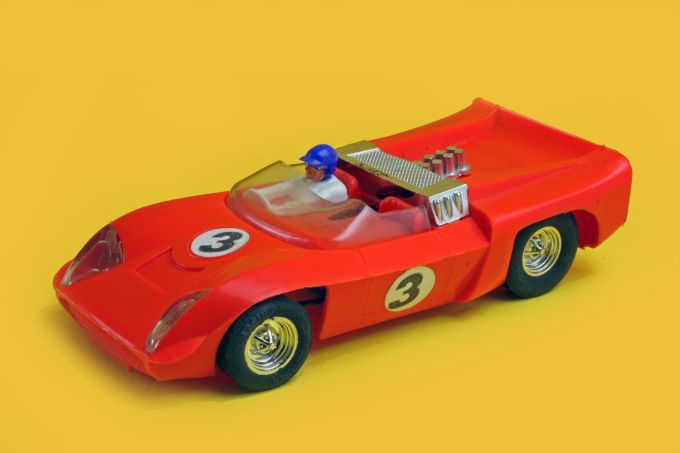Electra is one of the most popular Greek mythological characters in tragedies. She is the main character in two Greek tragedies, Electra by Sophocles and Electra by Euripides. In our modern world, of course, Electra is simply a model in the Scalextric range. Unlike, the Greek relation, our Electra is not the most popular. Quite the reverse, in fact. The standard orange Electra, usually bearing the scars of a warped or splintered windscreen and a tardy complexion due to many of its own racing tragedies, it is definitely not one most of us care to remember.

As a collectable item it has many variations. Ten distinct colours are recorded. Ten! Yes, there are and body variations also cover a similar number. Many collectors don’t give the orange Electra a second glance but may be missing out on an interesting item.
The Electra was designed, perhaps, to give a Can-Am flavour to the Scalextric range and was released in 1968 in the usual orange colour under reference C4-11 moulded on the underside of the body. The plastic was of a cheap quality and would scuff very easily. The model doesn’t have a chassis but a motor and axle assembly that screws together to form a solid unit that clips in to the driver-pan. All were fitted with G20 guide blade and aluminium motor mount for an E7 Raymond electric motor and all were made in the UK with the exception of a yellow model which was produced in the USSR under licence (probably!). All Electra models bear the mark ‘C4-11’ which the manufacturer chose to indicate that both C4 and C11 were to be released in 1968 so that they didn’t have to insert a ‘C’ ref ID in the mould tooling. Efficient but a little short-sighted as the very next year Scalextric released C13, another Electra! So, C13 still shows ‘C4-11’ embossed on the underside! However, the factory did manage to produce a number of Electra with the marking ‘C3-11’ as well as blank IDs! Two chromed wheel types were used; five-spoke and six-spoke versions.
Surprisingly, perhaps, for such a cheaply made racing car there was quite a bit of development behind the model even though it would never set the track alight. Let’s have a look at the evolution.
The first release of the Electra in 1968 had a ‘number plate’ (perhaps a radiator) under the front grill, a flat rear panel and round wheel arches. Why there would be any need for changes to the moulding is unclear but nevertheless in 1969 the rear arches were slightly squared off, a rim was added to the entire rear panel and the ‘number plate’ at the front was removed. Why? A mystery! The development team or tool-maker wasn’t finished yet! In the same year a wide wheel arch extension was added. A rear wing was added during the year which required two slots in the rear deck.
There was also an amendment to the driver pan with supporting ribs added to support the motor clip. Despite all these changes, the weakest part of the car was the windscreen and roll-over bar!
| Type | 1 | 2 | 3 | 4 | 5 | 6 |
| Year | 1968 | 1969 | 1969 | 1969 | 1969 | 1969 |
| ID | C4-11 | C3-11 | C4-11 | C4-11 | C4-11 | C4-11 |
| Front ‘Number plate’ | Yes | No | No | No | No | No |
| Rim around rear panel | No | No | Yes | Yes | Yes | Yes |
| Slots in rear deck for wing | No | No | No | No | Yes | Yes |
| Rounded rear wheel arches | Y | Y | ||||
| Squared-off rear wheel arches | Y | Y | ||||
| Squared-off rear wheel arches with extended lip. | Y | Y | ||||
The C11 issue was a Race Tuned version with a red can motor and the C13 issue was known as the Tiger version with black Tiger-like markings on the bonnet.
These body amendments are obvious when compared side-by-side but who takes the time to look at an Electra for more than a few seconds!
What is of interest are the colour variations. Orange is the standard and, essentially, there were not meant to be any other apart from green which is quite hard to find but by no means impossible and is the only official alternative colour. Orange and green.
However, as we have learnt with other cars the ‘art’ of creating the correct shade of dye isn’t an exact science by any means. Consequently, shades of orange can be found ranging from a light-ish orange through to red.
The unusual colours are almost all Type 1 bodies in translucent blue, green and orange which were possibly mould flushes. There are also a very rare Type 1 black and white models of which only one of each are known to exist to date. A yellow example also exists on a Type 1 body.
Finally, a yellow example on a Type 5 body was produced as part of the NOVO commercial tie-up with USSR. This C13 Tiger body has ‘Made in USSR’ (in English) embossed on the underside and was possibly a test to see if the model was a good fit for the USSR market.
The story of Electra, the daughter of Agamemnon, is a brutal tale. Yup, I think the Scalextric Electra story is as equally tragic. The opportunity was there to make a great racing car using in-house design but it was not to be.
Reference: Scalextric Ultimate Guide, 8th Edition,
If you believe you have a yet unrecorded variant and seek confirmation of its authenticity, please contact me at slotcarportal.com.
“Scalextric – The Ultimate Guide 8th Edition” book, with over 700 pages, is available from the Internet. Search online!





